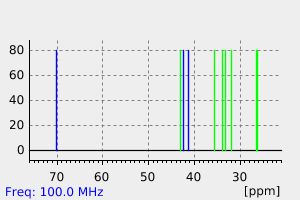(+/-)-trans,cis-decahydro-2-naphthol | 36667-73-9
中文名称
——
中文别名
——
英文名称
(+/-)-trans,cis-decahydro-2-naphthol
英文别名
4aαH,8aβH-decahydronaphthalen-2α-ol;(2R*,4aR*,8aR)-decahydro-2-naphthol;cis,trans-2-decalol;trans,cis-2-decalol;trans-decalin-2-ol;(4ar,8at)-decahydro-naphthalen-2c-ol;(2R,4aR,8aR)-1,2,3,4,4a,5,6,7,8,8a-decahydronaphthalen-2-ol
CAS
36667-73-9
化学式
C10H18O
mdl
——
分子量
154.252
InChiKey
UPMAOXLCTXPPAG-OPRDCNLKSA-N
BEILSTEIN
——
EINECS
——
-
物化性质
-
计算性质
-
ADMET
-
安全信息
-
SDS
-
制备方法与用途
-
上下游信息
-
文献信息
-
表征谱图
-
同类化合物
-
相关功能分类
-
相关结构分类
计算性质
-
辛醇/水分配系数(LogP):2.9
-
重原子数:11
-
可旋转键数:0
-
环数:2.0
-
sp3杂化的碳原子比例:1.0
-
拓扑面积:20.2
-
氢给体数:1
-
氢受体数:1
上下游信息
反应信息
-
作为反应物:描述:(+/-)-trans,cis-decahydro-2-naphthol 在 potassium pyrosulfate 、 permanganate(VII) ion 、 sodium carbonate 作用下, 生成 cyclohexane-1,2-diyldi-acetic acid参考文献:名称:Hueckel; Friedrich, Justus Liebigs Annalen der Chemie, 1927, vol. 451, p. 159摘要:DOI:
-
作为产物:描述:参考文献:名称:Kimura, Memoirs of the College of Science, Kyoto Imperial University, 1931, vol. 14, p. 173,179-182摘要:DOI:
文献信息
-
Directive Effect of the 2- and 3-Axial Hydroxy Groups That Appeared in the Complex Metal Hydride Reduction of Cyclohexanones作者:Yasuhisa Senda、Nobuhito Kikuchi、Ayuko Inui、Hiroki ItohDOI:10.1246/bcsj.73.237日期:2000.1significant directive effect of the 2-axial hydroxy group appeared in the LiAlH4, NaBH4, and Zn(BH4)2 reduction of cyclohexanone, while the 3-axial hydroxy group exhibited a steric hindrance. The distance between the carbonyl carbon and the hydroxy group which interacts with the hydride reagent is mainly responsible for such a difference. In the reduction of Na[B(OAc)3H], both the 2- and 3-axial hydroxycyclohexanones
-
Synthesis of Poly(decahydro-2-naphthyl methacrylate)s with Different Geometric Structures and Effects of Side-Group Dynamics on Polymer Properties Investigated by Thermal and Dynamic Mechanical Analyses and DFT Calculations作者:Anri Ozaki、Koha Sumita、Kunihiro Goto、Akikazu MatsumotoDOI:10.1021/ma400254d日期:2013.4.23prepared the geometric isomers of decahydro-2-naphthols as the source materials for the synthesis of poly(decahydro-2-naphthyl methacrylate)s [poly(DNMA)-I, -II, -III, and -IV] including alicyclic ester groups with different geometric structures. The geometry and conformational dynamics of the decahydro-2-naphthyl moieties were investigated by NMR spectroscopy and DFT calculations. We synthesized each我们制备了十氢-2-萘的几何异构体,作为合成聚(十氢-2-甲基丙烯酸萘酯)[聚(DNMA)-I,-II,-III和-IV]包括脂环族酯的原料不同几何结构的人群。通过NMR光谱法和DFT计算研究了十氢-2-萘基部分的几何构型和构象动力学。我们合成了甲基丙烯酸单体的每种异构体,将它们聚合,并研究了具有不同异构体组成的聚(DNMA)的光学,热学和机械性能。的Ť克聚(DNMA)的值按以下顺序排列:聚(DNMA)-II的139.3°C <142.7°C聚(DNMA)-I的<142.7°C聚(DNMA)-III的<146.2°C用于聚(DNMA)-III / IV。根据通过动态力学分析确定的脂环族取代基的动态运动,对于聚(DNMA)-I,观察到由于β-松弛引起的侧基构象变化的tanδ峰,而没有峰。观察到聚(DNMA)-III。包括四个组成各异的酯基团的聚(DNMA)-I的β-松弛活化能为65 kJ /
-
Hydrogenation and Hydrogenolysis. XVII. The Selectivities of Platinum Group Metals in Catalytic Hydrogenation of 2-Naphthol and Tetrahydro-2-naphthols作者:Shigeo Nishimura、Shin-ichi Ohbuchi、Kiyoshi Ikeno、Yasuhiro OkadaDOI:10.1246/bcsj.57.2557日期:1984.9Catalytic hydrogenation of 2-naphthol (NL) with the six platinum metals has been studied in t-BuOH at 80 °C and 4–5 MPa H2 pressure. Selectivities for formation of 1,2,3,- and 5,6,7,8-tetrahydro-2-naphthols (ac- and ar-TLs) have been determined by application of a kinetic equation. ar-TL was formed more predominantly than ac-TL over all the metals. The hydrogenation of ac- and ar-TLs has also been在 80 °C 和 4-5 MPa H2 压力下,在 t-BuOH 中研究了 2-萘酚 (NL) 与六种铂金属的催化氢化。1,2,3,- 和 5,6,7,8-四氢-2-萘酚(ac-和 ar-TL)的形成选择性已通过应用动力学方程确定。在所有金属中,ar-TL 的形成比 ac-TL 更显着。为了比较,还在相同条件下研究了 ac-和 ar-TLs 的氢化。NL 和 ar-TL 的氢化伴随着广泛的氢解作用,在 Os、Ir 和 Pt 上产生十氢化萘,而在 Ru、Rh 和 Pd 上仅发生轻微的氢解作用。一般来说,使用 ac-TL 发生的氢解程度要小得多。ar-TL 氢化中形成的 2-十酮的量已通过应用动力学方程确定。除了 Pd 外,2-十酮是顺式异构体。为了在环接点形成顺式产物,ar-TL 的氢化对 Ru、Rh、Os 和 Ir 具有高度立体选择性,wh...
-
Studies on the stereochemistry of reduction reactions on 10-R substituted trans decal-2-Ones作者:Giorgio Di Maio、Luisa M. Migneco、Elisabetta VecchiDOI:10.1016/s0040-4020(01)87929-1日期:1990.1Relative rates kax and keq of reduction reactions of title compounds (R=H, Me, CO2Et, Cl) have been measured in three different reaction conditions (LiAlH4, LiEt3BH, NaBH4). We found that keq decreases as the substituent electronegativity increases when lithium reactants are used and that kaxincreases as the substituent electronegativity increases when sodium reactant is used. The synthesis of trans
-
Reaktionen mit Mikroorganismen. 11. Mitteilung. Die Reduktion und Oxydation von (±)-<i>trans</i>- und (±)-<i>cis</i>-Dekalon-(2) mit<i>Curvularia falcata</i>作者:V. Prelog、H. E. SmithDOI:10.1002/hlca.19590420735日期:——Curvularia falcata (TEHON) BOEDIJN reduziert das (±)-trans-Dekalon-(2) (I, II) zu zwei diastereomeren Paaren von enantiomeren trans-Dekalolen-(2) (III bis VI), von welchen diejenigen mit (2 S)-Konfiguration überwiegen.镰刀菌(TEHON)BOEDIJN将(±)-反式十烯酮-(2)(I,II)还原为对映体反式十烯酮-(2)(III至VI)的两个非对映异构体对,其中以(2 S)配置占主导地位。
表征谱图
-
氢谱1HNMR
-
质谱MS
-
碳谱13CNMR
-
红外IR
-
拉曼Raman
-
峰位数据
-
峰位匹配
-
表征信息
同类化合物
(反式)-4-壬烯醛
(s)-2,3-二羟基丙酸甲酯
([1-(甲氧基甲基)-1H-1,2,4-三唑-5-基](苯基)甲酮)
(Z)-4-辛烯醛
(S)-氨基甲酸酯β-D-O-葡糖醛酸
(S)-3-(((2,2-二氟-1-羟基-7-(甲基磺酰基)-2,3-二氢-1H-茚满-4-基)氧基)-5-氟苄腈
(R)-氨基甲酸酯β-D-O-葡糖醛酸
(5,5-二甲基-2-(哌啶-2-基)环己烷-1,3-二酮)
(2,5-二氟苯基)-4-哌啶基-甲酮
龙胆苦苷
龙胆二糖甲乙酮氰醇(P)
龙胆二糖丙酮氰醇(P)
龙胆三糖
龙涎酮
齐罗硅酮
齐留通beta-D-葡糖苷酸
鼠李糖
黑芥子苷单钾盐
黑海棉酸钠盐
黑木金合欢素
黑曲霉三糖
黑介子苷
黄尿酸8-O-葡糖苷
麻西那霉素II
麦迪霉素
麦芽糖脎
麦芽糖基海藻糖
麦芽糖1-磷酸酯
麦芽糖
麦芽四糖醇
麦芽四糖
麦芽十糖
麦芽六糖
麦芽五糖水合物
麦芽五糖
麦芽五糖
麦芽五糖
麦芽三糖醇
麦芽三糖
麦芽三糖
麦芽三塘水合
麦芽七糖水合物
麦芽七糖
麦法朵
麦可酚酸-酰基-Β-D-葡糖苷酸
麦利查咪
麝香酮
鹤草酚
鸢尾酚酮 3-C-beta-D-吡喃葡萄糖苷
鸡矢藤苷







